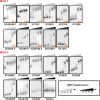Regulatory targets of quorum sensing in Vibrio cholerae: evidence for two distinct HapR-binding motifs
- PMID: 19276207
- PMCID: PMC2677876
- DOI: 10.1093/nar/gkp121
Regulatory targets of quorum sensing in Vibrio cholerae: evidence for two distinct HapR-binding motifs
Abstract
The quorum-sensing pathway in Vibrio cholerae controls the expression of the master regulator HapR, which in turn regulates several important processes such as virulence factor production and biofilm formation. While HapR is known to control several important phenotypes, there are only a few target genes known to be transcriptionally regulated by HapR. In this work, we combine bioinformatic analysis with experimental validation to discover a set of novel direct targets of HapR. Our results provide evidence for two distinct binding motifs for HapR-regulated genes in V. cholerae. The first binding motif is similar to the motifs recently discovered for orthologs of HapR in V. harveyi and V. vulnificus. However, our results demonstrate that this binding motif can be of variable length in V. cholerae. The second binding motif shares common elements with the first motif, but is of fixed length and lacks dyad symmetry at the ends. The contributions of different bases to HapR binding for this second motif were demonstrated using systematic mutagenesis experiments. The current analysis presents an approach for systematically expanding our knowledge of the quorum-sensing regulon in V. cholerae and other related bacteria.
Figures




References
-
- Vezzulli L, Guzman CA, Colwell RR, Pruzzo C. Dual role colonization factors connecting Vibrio cholerae's lifestyles in human and aquatic environments open new perspectives for combating infectious diseases. Curr. Opin. Biotechnol. 2008;19:254–259. - PubMed
-
- Waters CM, Bassler BL. Quorum sensing: cell-to-cell communication in bacteria. Annu. Rev. Cell Dev. Biol. 2005;21:319–346. - PubMed
-
- Meibom KL, Blokesch M, Dolganov NA, Wu CY, Schoolnik GK. Chitin induces natural competence in Vibrio cholerae. Science. 2005;310:1824–1827. - PubMed
-
- Hammer BK, Bassler BL. Quorum sensing controls biofilm formation in Vibrio cholerae. Mol. Microbiol. 2003;50:101–104. - PubMed
Publication types
MeSH terms
Substances
Grants and funding
LinkOut - more resources
Full Text Sources
Molecular Biology Databases

